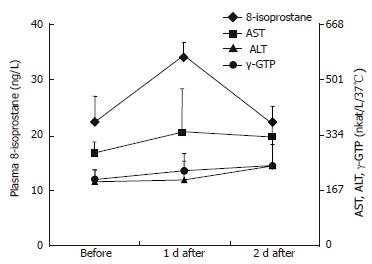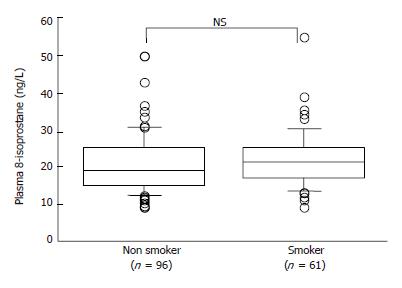Copyright
©2006 Baishideng Publishing Group Co.
World J Gastroenterol. Sep 28, 2006; 12(36): 5846-5852
Published online Sep 28, 2006. doi: 10.3748/wjg.v12.i36.5846
Published online Sep 28, 2006. doi: 10.3748/wjg.v12.i36.5846
Figure 1 Flow chart of the improved ELISA for plasma 8-isoprostane.
Figure 2 Results of the second extraction step using an NH2 Sep-Pac column to isolate the plasma 8-isoprostane.
Spiked plasma samples containing 3H-labeled 8-isoprostane, PGF2α, TXB2, 6-keto-PGF1, PGE2 or PGD2 were used. Samples extracted with ODS gel were used to assess the absorption by, washing and elution from the NH2 Sep-Pac column.
Figure 3 Dilution curves of plasma 8-isoprostane in 3 different plasma samples ( ▲ y = 227.
6x-2.34, r = 0.999; ■ y = 126.3x + 0.06, r = 1.000; ◆ y = 21.8x-0.04, r = 0.999).
Figure 4 Changes in AST, ALT, γ-GTP and plasma 8-isoprostane after alcohol intake.
The levels of plasma 8-isoprostane in the 3 individuals increase significantly on d 1 after drinking, but return to their original levels on d 2. No significant changes are observed in AST, ALT and γ-GTP.
Figure 5 Effect of smoking habit on plasma 8-isoprostane levels.
The levels of plasma 8-isoprostane were not significantly different between non smokers and smokers (21.5 ± 7.3 vs 22.8 ± 7.4 ng/L).
- Citation: Kitano S, Hisatomi H, Hibi N, Kawano K, Harada S. Improved method of plasma 8-Isoprostane measurement and association analyses with habitual drinking and smoking. World J Gastroenterol 2006; 12(36): 5846-5852
- URL: https://www.wjgnet.com/1007-9327/full/v12/i36/5846.htm
- DOI: https://dx.doi.org/10.3748/wjg.v12.i36.5846













